
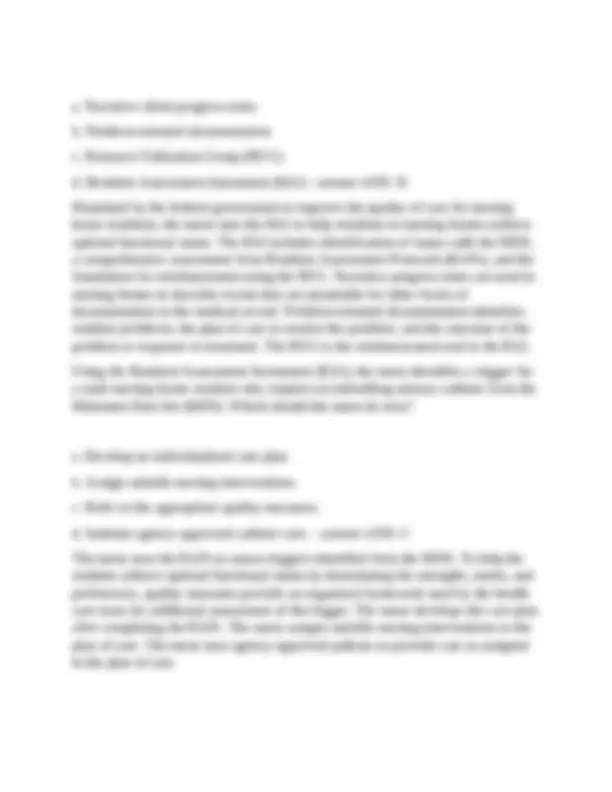
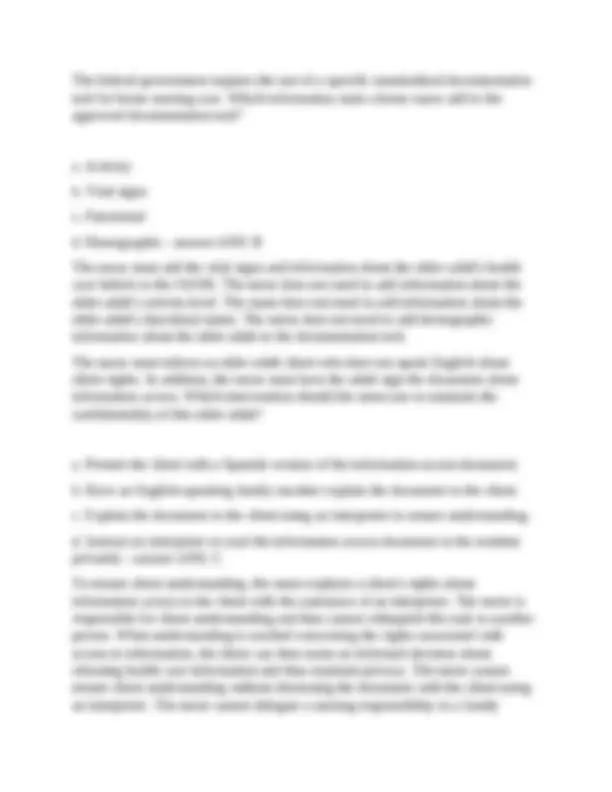
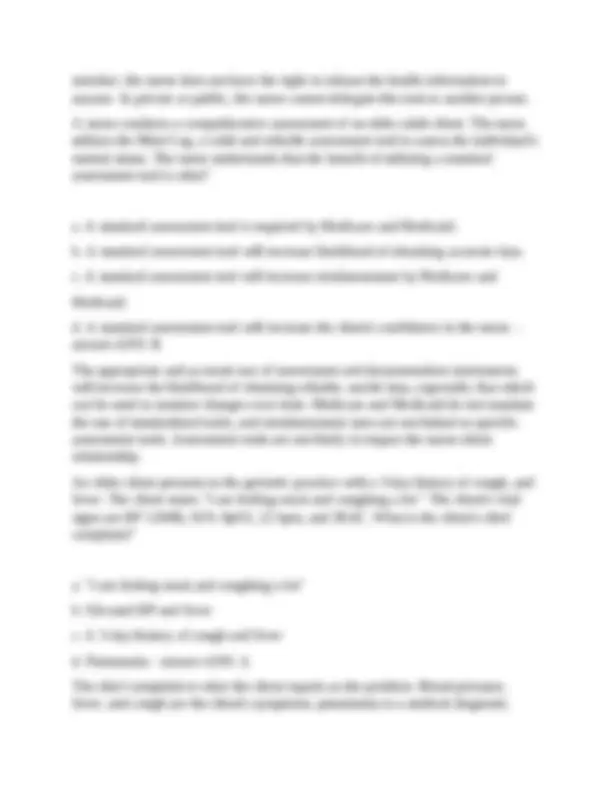
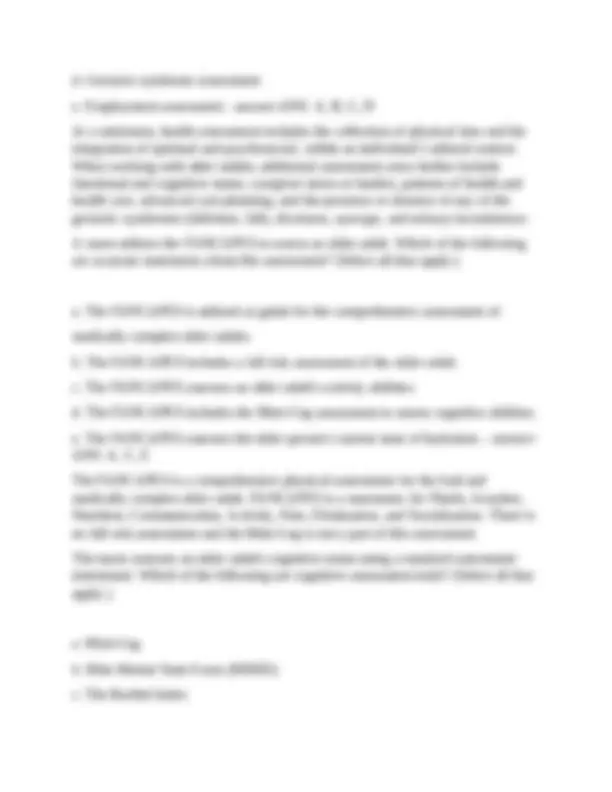
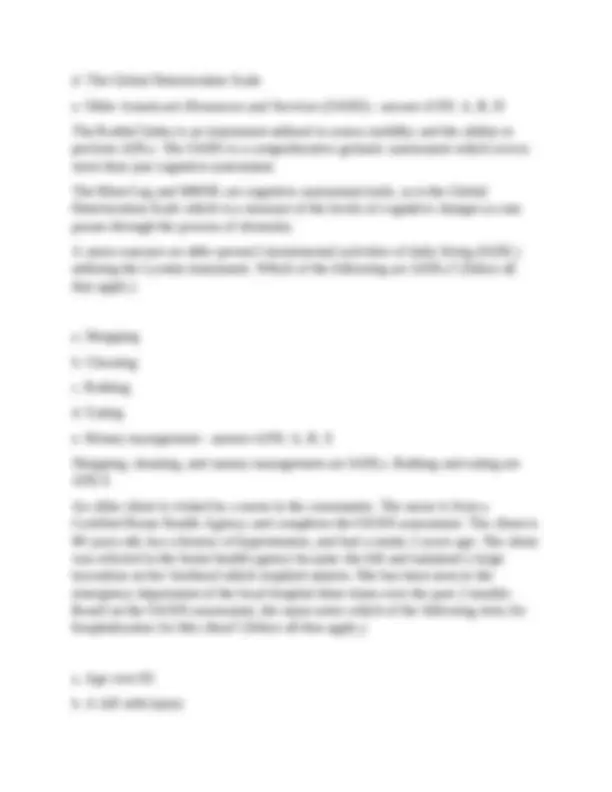
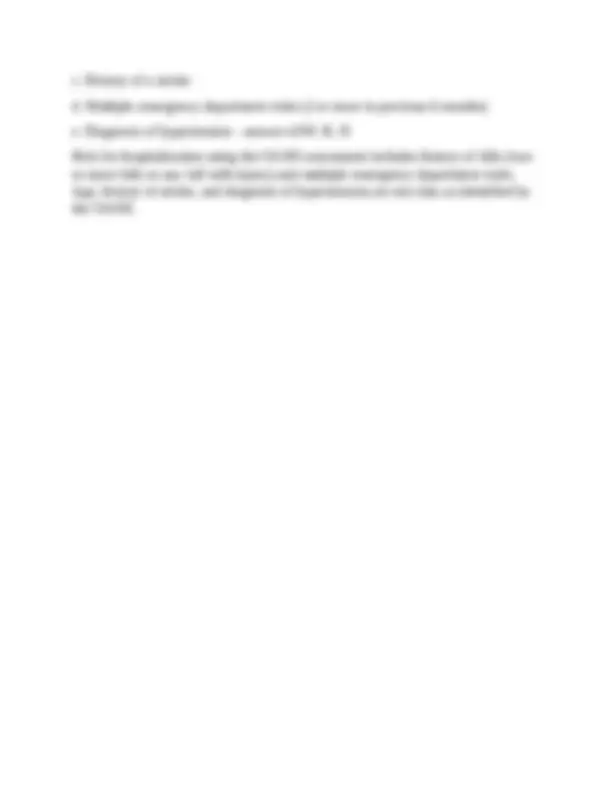


Study with the several resources on Docsity

Earn points by helping other students or get them with a premium plan


Prepare for your exams
Study with the several resources on Docsity

Earn points to download
Earn points by helping other students or get them with a premium plan
Community
Ask the community for help and clear up your study doubts
Discover the best universities in your country according to Docsity users
Free resources
Download our free guides on studying techniques, anxiety management strategies, and thesis advice from Docsity tutors
A series of multiple-choice questions and answers related to recognizing and analyzing cues in gerontological nursing. It covers topics such as documentation, assessment tools, and client care considerations in the context of geriatric nursing. The questions are designed to test understanding of key concepts and practices in gerontological nursing.
Typology: Exams
1 / 10

This page cannot be seen from the preview
Don't miss anything!







Which of the following is a true statement about documentation? a. Nurses should keep records of clients' wishes. b. Clients do not have access to their own medical records. c. The Outcomes and Assessment Information Set (OASIS) is a complete record of the health status of a client. d. The nurse is responsible for completing all of the Minimum Data Set (MDS). - answer-ANS: A Entering clients' expressed wishes in the medical or clinical record helps ensure that the interdisciplinary team respects these wishes. According to regulations after the enactment of the Health Insurance Portability and Accountability Act (HIPAA), the client has access to his or her own medical records and may designate others to have access. The OASIS is used to measure outcomes for quality improvement purposes; it does not contain all of the necessary information for care, such as vital signs. The MDS should be completed jointly by all members of the interdisciplinary team. Which one of the following is connected with the nursing home reform mandated by a 1987 law? a. Resident Assessment Instrument (RAI) b. HIPAA c. OASIS d. Fulmer SPICES - answer-ANS: A The RAI must be completed for all residents receiving Medicare or Medicaid. The HIPAA was passed in 1996 and mandates privacy practices. The OASIS is an
assessment designed for use in the home health care setting. Fulmer SPICES is an overall assessment tool developed in 2007. An older adult client has diabetes mellitus and requires hemodialysis for renal failure. The client is discharged to home to recover from a sternal wound infection and coronary artery bypass graft surgery (CABG). A home care nurse will provide wound care. Which of the following is the major justification for the complete and accurate documentation of this client's care? a. Requires complex health care b. Has needs in multiple settings c. Is at risk for iatrogenic problems d. Has significant health care expenses - answer-ANS: A The major reason that documentation of this client's health care must be accurate and complete is that she has complex health care needs in multiple settings and experiences a high risk for iatrogenic problems and high reimbursement expenses. The duration of her care is likely to be lengthy; the sternal wound infection after CABG is serious because of the potential for sternal osteomyelitis. In addition, individuals with diabetes are at high risk for infection and are slow to heal. The complexity of the care includes receiving care in multiple settings—at home, at dialysis, and in primary care for post discharge follow-up care. For an older adult with diabetes, coronary artery disease, renal failure, and a serious infection, each facet of health care depends on complete and accurate data on the other aspects of her care to help her achieve optimal health and wellness. This older adult is at risk for iatrogenic problems because of the complexity of care. Each type of care, each illness or condition, and each setting exposes this older adult to a separate set of risks. In addition, individuals with diabetes can have peripheral neuropathies that increase the risk for falls and injuries. This older adult incurs health care expenses dealing with complex health care requirements including a recent hospital stay for surgery and complicated by an infection, ongoing needs for hemodialysis, and home care. Because much of the care is nurse driven, documentation is the basis for which reimbursement is provided. Which documentation tool does the nurse use to achieve optimal functional status for a nursing home resident?
The federal government requires the use of a specific standardized documentation tool for home nursing care. Which information must a home nurse add to the approved documentation tool? a. Activity b. Vital signs c. Functional d. Demographic - answer-ANS: B The nurse must add the vital signs and information about the older adult's health care beliefs to the OASIS. The nurse does not need to add information about the older adult's activity level. The nurse does not need to add information about the older adult's functional status. The nurse does not need to add demographic information about the older adult to the documentation tool. The nurse must inform an older adult client who does not speak English about client rights. In addition, the nurse must have the adult sign the document about information access. Which intervention should the nurse use to maintain the confidentiality of this older adult? a. Present the client with a Spanish version of the information access document. b. Have an English-speaking family member explain the document to the client. c. Explain the document to the client using an interpreter to ensure understanding. d. Instruct an interpreter to read the information access document to the resident privately - answer-ANS: C To ensure client understanding, the nurse explains a client's rights about information access to the client with the assistance of an interpreter. The nurse is responsible for client understanding and thus cannot relinquish this task to another person. When understanding is reached concerning the rights associated with access to information, the client can then make an informed decision about releasing health care information and thus maintain privacy. The nurse cannot ensure client understanding without discussing the document with the client using an interpreter. The nurse cannot delegate a nursing responsibility to a family
member; the nurse does not have the right to release the health information to anyone. In private or public, the nurse cannot delegate this task to another person. A nurse conducts a comprehensive assessment of an older adult client. The nurse utilizes the Mini-Cog, a valid and reliable assessment tool to assess the individual's mental status. The nurse understands that the benefit of utilizing a standard assessment tool is what? a. A standard assessment tool is required by Medicare and Medicaid. b. A standard assessment tool will increase likelihood of obtaining accurate data. c. A standard assessment tool will increase reimbursement by Medicare and Medicaid. d. A standard assessment tool will increase the client's confidence in the nurse. - answer-ANS: B The appropriate and accurate use of assessment and documentation instruments will increase the likelihood of obtaining reliable, useful data; especially that which can be used to monitor changes over time. Medicare and Medicaid do not mandate the use of standardized tools, and reimbursement rates are not linked to specific assessment tools. Assessment tools are not likely to impact the nurse-client relationship. An older client presents to the geriatric practice with a 3-day history of cough, and fever. The client states "I am feeling weak and coughing a lot." The client's vital signs are BP 120/86, 92% SpO2, 22 bpm, and 38.6C. What is the client's chief complaint? a. "I am feeling weak and coughing a lot" b. Elevated BP and fever c. A 3-day history of cough and fever d. Pneumonia - answer-ANS: A The chief complaint is what the client reports as the problem. Blood pressure, fever, and cough are the client's symptoms; pneumonia is a medical diagnosis.
portion of the assessment addresses the functional capabilities of the client to perform activities of daily living. Which mental status assessment tool(s) would be appropriate for use in long-term care facilities? (Select all that apply.) a. Fulmer SPICES b. Clock Drawing Test c. The Mini-Cog d. Mini-Mental State Examination (MMSE) e. Montreal Cognitive Assessment (MoCA) - answer-ANS: B, C, D, E The Montreal Cognitive Assessment (MoCA) was designed as a brief screening instrument to provide cues leading to the hypothesis of mild cognitive impairment. The Clock Drawing Test, which has been used since 1992, is a screening tool that helps identify those with a cognitive impairment and is used as a measure of severity. The Mini-Cog was developed as a tool that could establish cognitive status more quickly than the MMSE and the limitations of educational adjustments. It is now the recommended evidenced-based tool and combines one aspect of the MMSE (short-term memory recall) with the test of executive function of the Clock Drawing Test. It has been found to be highly sensitive to diagnosing dementia. The MMSE tool has been used most often and is a 30-item instrument that has been used to screen for cognitive difficulties and is one of the tools often used in determining a diagnosis of dementia or delirium. Fulmer SPICES is an overall assessment tool developed in 2007. A nurse is assessing an older client. The nurse understands that in addition to the collection of physical data and the integration of spiritual and psychosocial issues, additional assessments commonly utilized for older adults include which of the following? (Select all that apply.) a. Functional status assessment b. Cognitive assessment c. Caregiver burden assessment
d. Geriatric syndrome assessment e. Employment assessment - answer-ANS: A, B, C, D At a minimum, health assessment includes the collection of physical data and the integration of spiritual and psychosocial, within an individual's cultural context. When working with older adults, additional assessment areas further include functional and cognitive status, caregiver stress or burden, patterns of health and health care, advanced care planning, and the presence or absence of any of the geriatric syndromes (delirium, falls, dizziness, syncope, and urinary incontinence. A nurse utilizes the FANCAPES to assess an older adult. Which of the following are accurate statements about this assessment? (Select all that apply.) a. The FANCAPES is utilized as guide for the comprehensive assessment of medically complex older adults. b. The FANCAPES includes a fall risk assessment of the older adult. c. The FANCAPES assesses an older adult's activity abilities. d. The FANCAPES includes the Mini-Cog assessment to assess cognitive abilities. e. The FANCAPES assesses the older person's current state of hydration. - answer- ANS: A, C, E The FANCAPES is a comprehensive physical assessment for the frail and medically complex older adult. FANCAPES is a mnemonic for Fluids, Aeration, Nutrition, Communication, Activity, Pain, Elimination, and Socialization. There is no fall risk assessment and the Mini-Cog is not a part of this assessment. The nurse assesses an older adult's cognitive status using a standard assessment instrument. Which of the following are cognitive assessment tools? (Select all that apply.) a. Mini-Cog b. Mini Mental State Exam (MMSE) c. The Barthel Index
c. History of a stroke d. Multiple emergency department visits (2 or more in previous 6 months) e. Diagnosis of hypertension - answer-ANS: B, D Risk for hospitalization using the OASIS assessment includes history of falls (two or more falls or any fall with injury) and multiple emergency department visits. Age, history of stroke, and diagnosis of hypertension are not risks as identified by the OASIS.